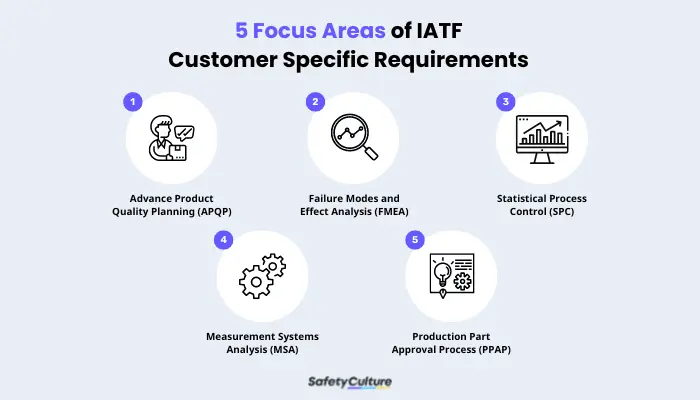What are Customer Specific Requirements?
Customer Specific Requirements (CSRs) are the requirements created or provided by the customer in agreement with the supplier or manufacturer. These guide organizations in the automotive industry in ensuring customer satisfaction. It’s important to understand that customer-specific requirements are an essential component of the Quality Management System (QMS) standard created by the International Automotive Task Force (IATF) for the automotive industry called the IATF 16949.
The IATF 16949 standard is another type of QMS standard alongside other popular and globally recognized ones like ISO 9001 and ISO 19011, which are created by the International Organization for Standardization (ISO).
What is the Difference Between Customer Requirements and Customer Specific Requirements?
According to the International Automotive Oversight Bureau (IAOB), customer requirements refer to those that focus on or are specific to the order or product, whether or not related to the IATF 16949 standard, and that are only specific to a customer.
On the other hand, customer-specific requirements are those that come from Original Equipment Manufacturers (OEMs) as a way to supplement the IATF 16949 standard or any requirement or clause stated therein. Hence, customer-specific requirements are a part of customer requirements in general.
Elements of a QMS in the Automotive Industry
CSRs
When establishing a QMS, organizations must use customer-specific requirements as a key source of information and considerations. Monitoring updates on CSRs is also a must, especially because they are considered external documents supplementing the IATF 16949 standard.
Documentation
An automotive organization that complies with a QMS standard like the IATF 16949 must have a quality manual. It should include a document—containing a customer-specific requirements matrix, table, or list—that outlines the aspects of the QMS where the customer-specific requirements are addressed.
Audit
When auditing a QMS using a checklist or audit template, an in-depth check on an organization’s processes is conducted. In this case, there must be a section allotted for the customer-specific requirements to verify implementation and compliance.
Improve your GRC management
Simplify risk management and compliance with our centralized platform, designed to integrate and automate processes for optimal governance.
Explore now5 Focus Areas of Customer Specific Requirements

5 Focus Areas of IATF Customer Specific Requirements
Customer-specific requirements often involve the following focus areas as prescribed by the IATF 16949 standard:
- Advance Product Quality Planning (APQP) – Used to guide suppliers in building product quality plans, APQP is important when developing new products, especially those that are safety-critical, and minimizing risks.
- Failure Modes and Effect Analysis (FMEA) – Regularly conducting FMEAs of manufacturing parts is encouraged at least every year. This is where suppliers can spot issues and commit to addressing them.
- Statistical Process Control (SPC) – For process control and continuous improvement, suppliers can use statistical methods to ensure quality in implementing CSRs.
- Measurement Systems Analysis (MSA) – Measurement processes must be analyzed by suppliers using MSA, an experimental and mathematical method, to identify their amount of variation.
- Production Part Approval Process (PPAP) – The PPAP is an 18-step guideline for OEMs and suppliers that help them ensure they understand CSRs and that their manufacturing process produces conforming parts at the quoted production rate.
FAQs About Customer Specific Requirements
According to the IAOB, the auditing process of customer specific requirements in the manufacturing process must be integrated into the process audit in accordance with IATF 16949 instead of auditing it on its own. Further, it’s not required to audit all CSRs. Instead, the auditor must sample CSRs to check if they are being followed effectively.
An example of how to audit CSRs is when an auditor is on the shop floor or production facility to verify the implementation of customer specific requirements by asking the operator open-ended questions using a customer specific requirements checklist to gather objective evidence.
Know which customers have CSR documents and how your organization can gather them. Once gathered, establish a system of how you must communicate the CSRs across the organization through management reviews and work instruction updates.
Implementing CSRs involves continuous process updates and training of the new requirements for the responsible employees or stakeholders. Lastly, a third-party auditor must verify CSRs implementation at every level.
Bigger or established customers may have their CSRs linked on their website or a supplier portal. On the other hand, smaller organizations may need to be contacted through their suppliers.
You can also find customer specific requirements examples on the IATF website as well as supplier quality manuals.




